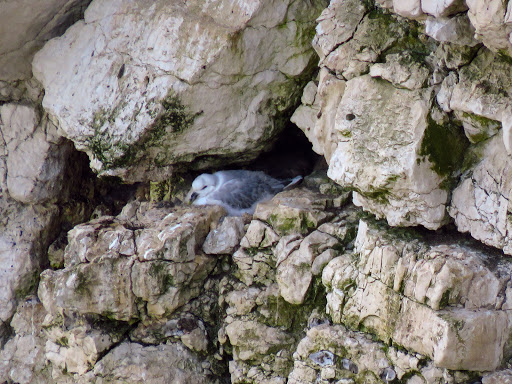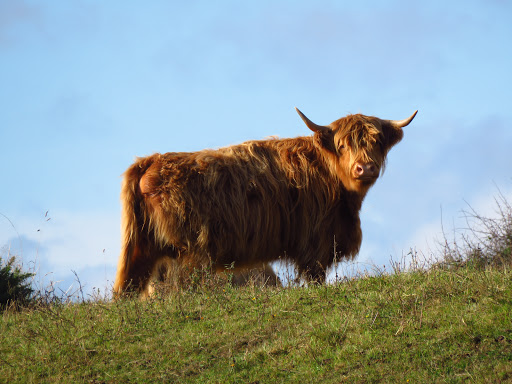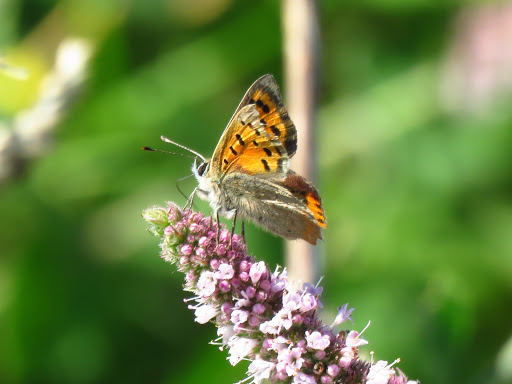
The day started cold. Ominous dark clouds remind me that rain could happen at any point, but it warmed up, and the skies cleared, leaving a lovely morning for a walk. A Kestrel hunts over the long grass, and a lone swift flies with the resident House Martins. Some Jackdaws feed on the still empty car park at North Landing. The tide is high, a spring tide too, of over 7 m, little beach left at the landing.
After a peek at the landing, I take the coastal path north. I'm glad I started early and I can enjoy the solitude of the cliffs. Groups of Gannets fly north in V formation. Fulmars fly incessantly by the cliffs, circling, wavering their wings when almost touching the rocks with their outstretched feet. Some Fulmar chicks can be seen hunkered down on their nests.
Fulmar chick.
I take the steps fown Holmes Gut, a small ravine clothed with scrub. I head water trickling down, but it runs under the brambles and hairy willowherb. Goldfinches and Linnets sit chattering and grooming on the gorse. By Holmes Gut there is a large patch of flowering mint with some fleabane. It is teeming with butterflies: my first Painted Lady of the year, Red Admiral, too many Small Tortoiseshells to count, and plenty of Silver Y moths, a Small Copper and two Common Blue. A highland cow looks on from the field above.
Red Admiral
Nabs and Nooks
In the first part of the walk the chalky cliffs are rugged, morphed by the erosion of rough seas: first broken into fissures, then into caves and arches. There are two accessible coves, North Landing, with with its slipway for cobbles, and Thornwick bay, but from there on many little coves (known as nooks or newks) and promontories (nabs). From Thornwick bay onwards there is barely any beach or intertidal platform at the bottom of the cliffs, the cliffs plunging into the depths, the sea constantly lapping the rocks by the cliff base. I look at the names on my map, detailing each feature of the cliffs: Close Nooks, Gull Nook, White Corner, Noon Nook, Cat Nab, Wandale Nab...

Thornwick Nab

The cliff climbs in height steadily, I'm approaching Danes Dyke, a line of trees marks this ancient monument from a distance. When I get to it, I scramble to the top and I am rewarded with an amazing view of the whole of the peninsula, photos don't really do it justice.
The cliffs by the north side of the dyke are already part of Bempton Cliffs RSPB nature reserve. The acrid smell of guano and the cackling, rattling calls of gannets advertise the reserve.

Seabird city
The chalk cliffs from North Landing to Bempton hold the largest mainland seabird colony in the UK, which is also of international importance. Eight seabirds breed on the cliffs: Fulmar, Gannet, Kittiwake, Herring Gull, Guillemot, Razorbill, Puffins, and Shag. Given their conservation value for seabirds, there are regular counts, with the the 2017 census giving totals of over 200,000 breeding birds.

I stop at the clifftop viewpoint at Staple Newk. This affords an aerial view of the gannet colony: the 'gugas' or gannet chicks are the darker birds, contrasting with the white adults. Nests are regularly spaced, just distant enough to avoid the bill of the neighbours. Gugas at Staple Newk are most now fully feathered, although there are chicks in a range of stages of growth, some all covered on down, others with down only on their heads in other areas of the cliffs. Gannets and Fulmars are the last chicks to fledge the cliffs, most Kittiwakes and auks have already gone.
Staple Newk in the distance.
The gugas at Staple Newk are mostly feathered and ready to fledge. When checking the photo I noticed one of the adults has a red ring marked 'N3'. David Aitken on twitter confirmed that this individual was ringed in 2018 as part of a study and has returned to the cliffs every year since.
A fully feathered guga.
A more downy chick.
Another downy chick, away from Staple Newk, close to the clifftop.
This was the youngest guga I saw today.
The cliffs were busy with non breeding Gannets too. Gannets don't usually breed until their fifth years, and they gain their adult plumage in stages and can be aged by the extent of black on body. Non-breeders roam widely but eventually return to their natal colony, assembling in groups called 'clubs'. There they do a fair amount of displaying, helping them with their social skills and also with pair formation.
Pulling grass. Males are in charge of nest building.
A second year Gannet preening.
Displaying to a neighbour in the club.
Gannets pair for life. The partners engage in billing and grooming display. This is likely to be a young non-breeding pair. They are grooming pair after the 'territorial' dispute with the bird behind.
A Gannet squadron returning to the cliffs.
Not only Gannets are about though.

A resting Herring Gull.
After a coffee and snack at the RSPB visitor centre, I walk around the back of the reserve. By the car park, plenty of Willow Warblers feeding on the hedgerows and trees. A male common darter patrols the pond.
It's time to walk back. The sun is shining and the views are well worth walking the same way I came.a Fulmar flies by the cliffs.
A view of North Cliff.
Meadow Pipit.
Migrants
Flamborough is a top migration hotspot and the area is very well recorded, with the Flamborough Bird Observatory (FBO) engaged in bird ringing, sea watching, breeding bird surveys and producing an annual report detailing species summaries and articles on the activities of the observatory.
It is autumn migration season now and birds (an some insects) are already returning to their winter quarters, some after having finished breeding.
Painted Lady, a migratory butterfly. I had my first Painted Ladies of the year today, it hasn't been a great year for them.
Dozens of silver Y also fed on mint and knapweed. This is a strongly migrant moth.
Two Wheatears fed on a grassy field, but they had no peace, as a family of wagtails were not very happy to share and kept harassing them.
Wheatear.
Near Holmes Gut, I spotted some distant birds flycatching. There were two Whinchats, my first this year.
Whinchat Record shot.
A sunbathing young Goldfinch at Holmes Gut.
Featured bird: Northern Gannet
The Gannet is the largest and one of the most spectacular seabirds in Europe. Being heavy birds, they need updrafts to take flight, which is one of the reasons why they breed in rocky islands and sheer cliffs, another being to be safe from predation and human disturbance. They are highly colonial, with breeding populations concentrating in a few gannetries, that have some times been occupied for centuries. Bempton holds the only English mainland gannetry, with the latest census (2017) giving more than 13,000 pairs and over 1000 non-breeding individuals. Despite its Amber status in the UK, the gannetry at Bempton cliffs has been increasing steadily since it formed in the early 1960s, although nesting pairs had been seen regularly since as early as 1925, with a few young occasionally raised. Tracking studies have shown Bempton Gannets fishing trips can take them 100s of km away from the colony, all round the Holderness and North Yorkshire coasts and as far as Dogger Bank. Gannets are partial migrants. Although individuals can be seen year round off the Holderness coast, many adults overwinter in the Western Mediterranean and the Bay of Biscay while younger birds range further afield, reaching the West and Central African coasts.
The Gannet is the largest and one of the most spectacular seabirds in Europe. Being heavy birds, they need updrafts to take flight, which is one of the reasons why they breed in rocky islands and sheer cliffs, another being to be safe from predation and human disturbance. They are highly colonial, with breeding populations concentrating in a few gannetries, that have some times been occupied for centuries. Bempton holds the only English mainland gannetry, with the latest census (2017) giving more than 13,000 pairs and over 1000 non-breeding individuals. Despite its Amber status in the UK, the gannetry at Bempton cliffs has been increasing steadily since it formed in the early 1960s, although nesting pairs had been seen regularly since as early as 1925, with a few young occasionally raised. Tracking studies have shown Bempton Gannets fishing trips can take them 100s of km away from the colony, all round the Holderness and North Yorkshire coasts and as far as Dogger Bank. Gannets are partial migrants. Although individuals can be seen year round off the Holderness coast, many adults overwinter in the Western Mediterranean and the Bay of Biscay while younger birds range further afield, reaching the West and Central African coasts.
12 km. Start at North Landing car park TA238719, end at Bempton Cliffs RSPB visitor centre. Toilets at North Landing car park and Bempton Cliffs visitor centre. Access to beach at North Landing and Thornwick Bay.
More information
Aitken, D., Babcock, M., Barratt, A., Clarkson, C., Prettyman, S. Flamborough and Filey Coast pSPA Seabird Monitoring, 2017 Report.More information
Nelson, J. B. The breeding biology of the Gannet Sula bassana on the Bass Rock, Scotland. Ibis 108, 584–626 (2008).
Fisher, J. & Vevers, H. G. The Breeding Distribution, History and Population of the North Atlantic Gannet (Sula bassana). J. Anim. Ecol. 12, 173–213 (1943)
Bempton Birder blog, with almost daily posts on the cliffs events illustrated with fantastic photos.


































No comments:
Post a Comment